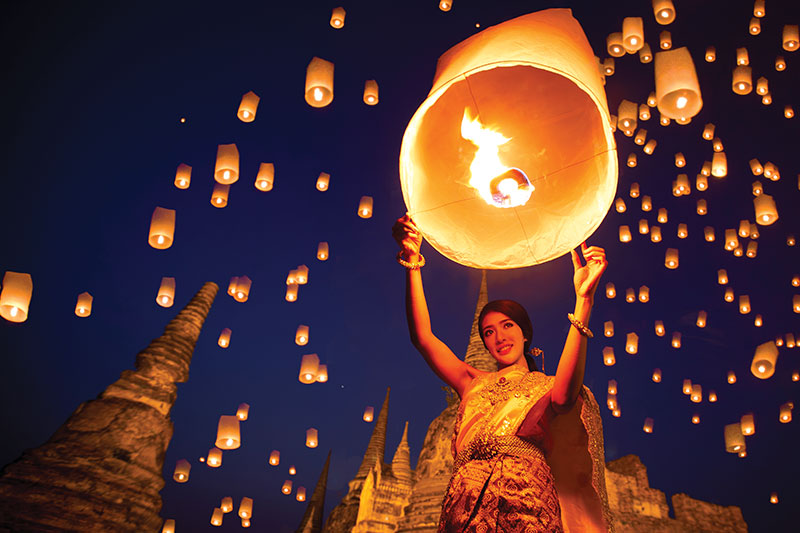
Thailand’s Fabulous Floating Festivals
What to see and do at the Loy Krathong and Yi Peng festivals
Words: Ron Emmons
Photos: Ron Emmons & Shutterstock
Every year, at the full moon in November (this year on the 15th), something wonderful happens to waterways throughout the Kingdom of Thailand. After dark, locals and visitors alike come to the riverside holding krathong – lotus – shaped floats adorned with flowers, incense sticks and a candle.
Then they light the candle, raise the float to their foreheads in silent prayer and release it onto the river to be carried away by the ceaseless flow; this action of floating is called loy in Thai. Multiply it by thousands, and the river’s surface becomes a glistening band studded with gems, echoing the stars above.
Meanwhile, others prepare to launch khom loy or sky lanterns into the night sky. These consist of a cylinder of rice paper held at top and bottom by rings of bamboo strips, with a wax coil and sometimes a string of firecrackers at the bottom.
When the coil is ignited, the heat pulls the lantern skyward and the people holding it make a wish as they let it sail into the night sky. As with the twinkling band of krathong on the river’s surface, these delicate airborne lanterns drift away in unison, creating a heavenly vision of thousands of glowing lights soaring towards the stars. For two nights these actions are constantly repeated in Thailand’s loveliest festival, called Loy Krathong, or Yi Peng in the North.
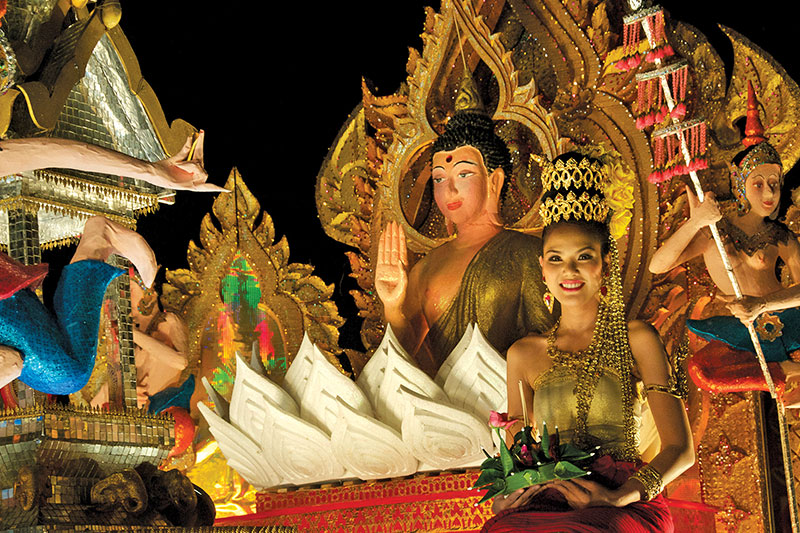
What’s the Difference?
But what’s the difference between Loy Krathong and Yi Peng? Basically, Loy Krathong is a nationwide event, while Yi Peng is held only in the North and dates back to the time before the region became part of Siam in 1932.
As mentioned, Loy Krathong means to float a krathong. Yi (sometimes written yee) means two and peng is the day of the full moon, so the name denotes the date of this festival, on the second full moon of the northern lunar calendar. This aligns with the 12th lunar month in the rest of Thailand.
By popular legend, Loy Krathong originated in 13th century Sukhothai, when Nang Noppamas, a consort of King Ramkhamhaeng, crafted a beautiful krathong that she floated on the river. No such fable is attached to Yi Peng, which simply marks the end of the rainy season and the beginning of the cool season.
The main activity at Loy Krathong is the making and releasing of krathong as an offering to Mae Khongkha, the goddess of water, to express thanks for the liquid that sustains life. Yi Peng by contrast is characterised by the launch of khom loy to let go of bad feelings and embrace a new beginning. Some people write out their wish and attach it to the sky lantern.
However, these days krathong and khom loy are released everywhere, and the two festivals happen at the same time, so visitors don’t need to fret about which festival to favour, as activities are similar throughout the country (for local variations, see box).
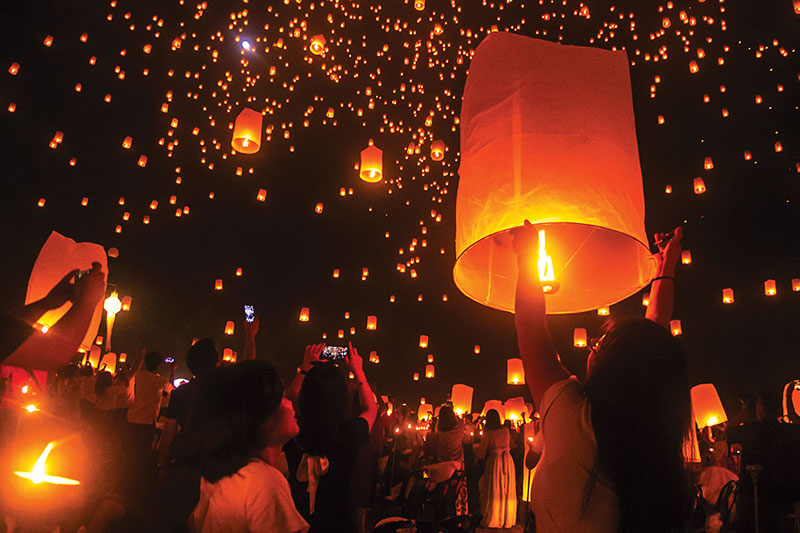
Festival Activities and Beliefs
Both festivals havwe their roots in Brahmanism and share similarities with India’s Diwali, the ‘festival of lights’. During the festival, Thais light small clay votive lamps called phang pratheep in front of their houses, and many decorate their gateways with banana stems and coconut fronds.
One reason this is such an enjoyable time for visitors to the kingdom is that it’s easy to participate in as well as watch events. Hotels and guest houses often organise krathong-making sessions where visitors learn how to decorate a slice of banana stem with waxy leaves in the shape of lotus petals, and then affix flowers, incense sticks and a candle to the base.
Besides thanking Mae Khongkha for nourishing the crops, releasing a krathong is also a chance to let go of any negative feelings and wipe the slate clean. To symbolise this, many Thais add a lock of their hair, a clip of their fingernails and a coin to their krathong.
Some believe that if a couple release their krathong at the same time, the route taken by the floats is an indicator of the future of their relationship. If they glide downstream together with their candles flickering brightly, all will be well, but if they diverge or the candles go out, the omens are not so good.
Making khom loy is not as easy as making krathong, but they are cheap to buy, and many hotels hand them out to guests.
As with krathong, at the moment of releasing a sky lantern, we should also let go of any grudges that we harbour towards our fellow humans and make a fresh start.
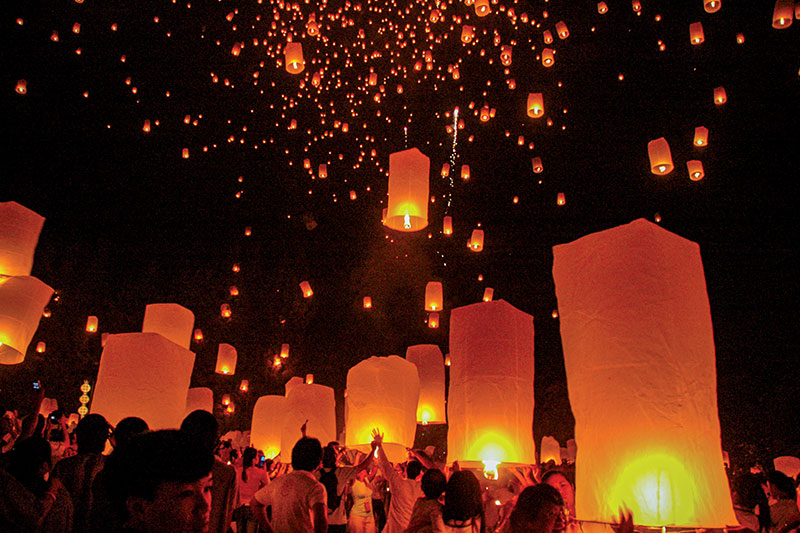
Parades and Lanterns
While floating krathong and launching khom loy form the highlight of these festivals, there are plenty of other activities such as colourful parades, beauty-queen competitions, firework displays and cultural performances.
Apart from khom loy, several other types of lantern feature in the festival, especially in Chiang Mai, which also includes a lantern parade on the evening before the small and big krathong parades, making three evenings of pageantry.
The simplest lantern is the khom thue, or portable lantern, which features in the parade, while khom kwaen are star-shaped or diamond-shaped and are used to beautify housefronts and shops. The most intricate are khom phat, or fan lanterns, which consist of two concentric cylinders that revolve when heated by a lamp inside to create a moving image.
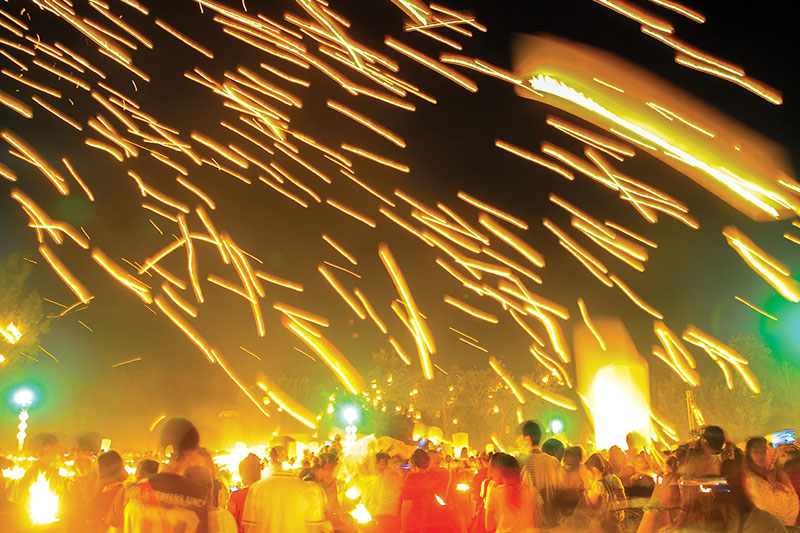
A Sustainable Festival?
Ironically, there is a downside to all these well-intentioned efforts to honour the goddess of water and to aim for the stars with sky lanterns, as the debris from the festival leaves an unsightly mess come daylight.
However, environmental awareness seems to be growing, and these days most participants are careful to select or make a krathong made of natural products that blend back into the environment without causing harm.
These floating festivals attract more and more visitors each year, but let’s hope that their bonding spirit will ensure that this inspiring spectacle continues to be re-enacted far into the distant future.

Where to see the Floating Festivals:
Bangkok: Take a dinner cruise on the Chao Phraya River, watch the shows at Asiatique Riverside or go to a temple such as Wat Arun.
Phuket: Float your krathong or khom loy at Patong Beach, Karon Lake or Nai Harn Lake.
Sukhothai: Book a ticket for the light & sound show (https://www. facebook.com/sukhothailoykrathong/) that portrays the legendary origins of this festival, from November 8-16.
Chiang Mai: Watch the lantern, small krathong and big krathong parades on Tha Pae Road, float a krathong from a riverside restaurant or join a mass release of sky lanterns such as https://yipengchiangmailanternfestival.com/.
Tak: Watch a string of thousands of krathong made of coconut shells float downstream from the footbridge over the Ping River.
